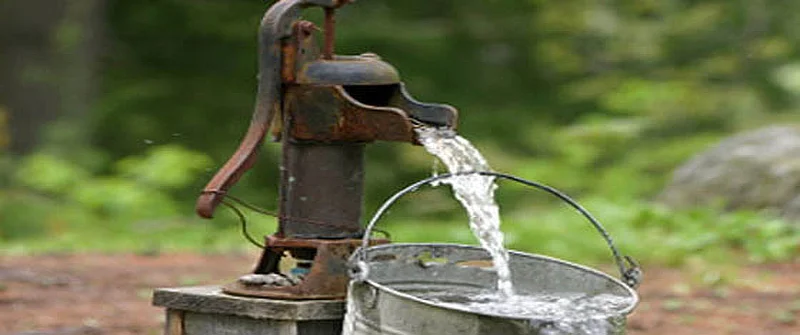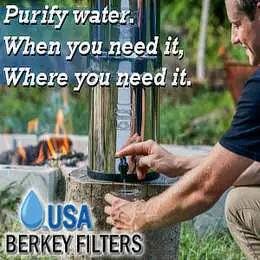Different Sources Of Water

WATER is a survival priority, and is taken for granted. From a preparedness standpoint, it’s good to think about different sources of water, just in case. Generally, we cannot survive much longer than 3 days without any of it. Some people have been known to survive for up to a week without water, but this has been a rare exception.
Knowing this, one would think that WATER is a top priority for most preppers. Unfortunately, it is often overlooked because most of us have such ready access to it nearly everywhere we go. It comes out of our faucet, and we can buy it in stores. It’s in lakes, rivers, and streams, and it rains (in most places)…
Stop to think about it though, because there are situations where your access to fresh clean drinking water could diminish or disappear. Here are a few notes about different sources of water.
Pro Tip: I HIGHLY RECOMMEND having a quality countertop water filter. It’s well worth the investment in my opinion. I have always been a fan of Berkey Water Filter Systems. My choice of distributor is USA Berkey Filters.

WATER SOURCES
The following are various water sources and a few notes for each. I originally posted this back in 2014, but it’s a timeless topic.
Municipal Water
Most everyone relies on their local water utility resource and distribution network.
- Safe drinking water, already treated
- Requires operating infrastructure, maintenance, and treatment supplies.
- Requires large pumps and electricity.
- Generator backup power will keep it flowing for a while after a power outage.
- Pipeline contamination possibility with major disasters.
- Know where your town’s water source is located (storage tanks and source).
- You are dependent on this system for survival (unless with a backup plan).
Well Water
Do you live rural? Then you probably have a well for your water source.
- Requires a well pump and holding tank (pressure tank).
- The pump needs electricity.
- Electricity could be from alternative methods (solar, battery bank, etc).
- A manual pump could be a solution, and advisable as backup.
- Rope and bucket, depending on well diameter.
- Depth of the well considerations.
- Cost of drilling and implementation.
- Water is pumped up to storage vessel containment.
- Size of storage considerations.
- Gravity feed from storage vessel for emergency (store higher than user location).
- Filtration/treatment for drinking, depending on source quality.
- Good overall self-reliant method (with appropriate backups for power, pump).
Lakes, Rivers, Streams, Ponds
Many people live near a lake, river, stream, or pond. However, many do not.
- Transportation of water to the intended location
- Water weighs about 8 pounds/gallon.
- Buckets, pails, lids, water jugs.
- Manual transportation, wagon, 2-wheel dolly, hand-truck, bicycle/trailer/saddlebags.
- Vehicle transportation if fuel is available.
- System of pipes with pump, if nearby to location.
- A gravity system may work, if applicable.
- Storage in vessels at the intended location.
- Water will need filtration and purification for drinking.
Spring Water
It’s a great resource if you’re lucky enough to have a natural spring on your property.
- Some springs are seasonal, while others provide a constant source of water flow throughout the year.
- Still requires transport or a pump to the dwelling.
Other Different Sources of Water Outside
Places to look for water:
- In valleys and low areas.
- Look at the foot of concave banks of dry river beds.
- At the foot of cliffs or rock outcrops.
- The first depression behind the first sand dune of dry desert lakes.
- Wherever you find damp surface sand.
- Wherever you find green vegetation.
- Dig a hole deep enough to allow water to seep in.
Swimming Pool
You may be surprised to discover how many swimming pools are in your area.
- You might consider a swimming pool to be an emergency water source.
- Unknowns regarding chemicals that may have been added.
- However, kids sometimes gulp pool water while swimming and live to see another day, so…
- Most pools are kept to less than 3ppm chlorine, which is safe for drinking
- However, long-standing untreated pool water will be devoid of chlorine.
- Filtration and purification are recommended.
- Know who has pools in your location. Use Google Earth to find them.
Hot Water Tank
Almost every home has a hot water tank, and it’s an emergency water source that may be overlooked.
- 40 to 50 gallons commonly available in a typical hot water tank.
- Safe to drink unless sitting unused for a long time.
- Use a length of hose to adapt the drain spigot to a bucket.
Toilet Holding Tank
Another small source of emergency water is the holding tank (not the bowl!)
- Several gallons of water are available in the holding tank.
- I would still filter it for drinking…
Store-bought Water Bottles
It is so easy to purchase cases of bottled water just in case.
- Easy storage of manageable sizes
- Portable. Good size for hiking or out with a backpack.
- Not the best long-term water storage plan, as they may eventually leak (thin plastic containment).
Long Term Water Storage
It’s always a good idea to keep some extra water stored for the long term.
- Use purpose-built water storage containers
- 5-gallon containers up to 55-gallon drums (or larger).
- Food-grade container (BPA-free), designed for water storage.
- Common recommendations of 1 to 3 gallons per person, per day.
- Keep storage out of sun and heat.
Rainwater Collection
You may be surprised how much water falls from the sky when it rains!
- A tarp will help capture rainwater
- Drainage and water runoff areas.
- Buckets.
- Rain gutters into barrels.
- Use drinking water filtration. It depends on the method of collection.
Gallons Of Rainwater Collection From A Tarp
